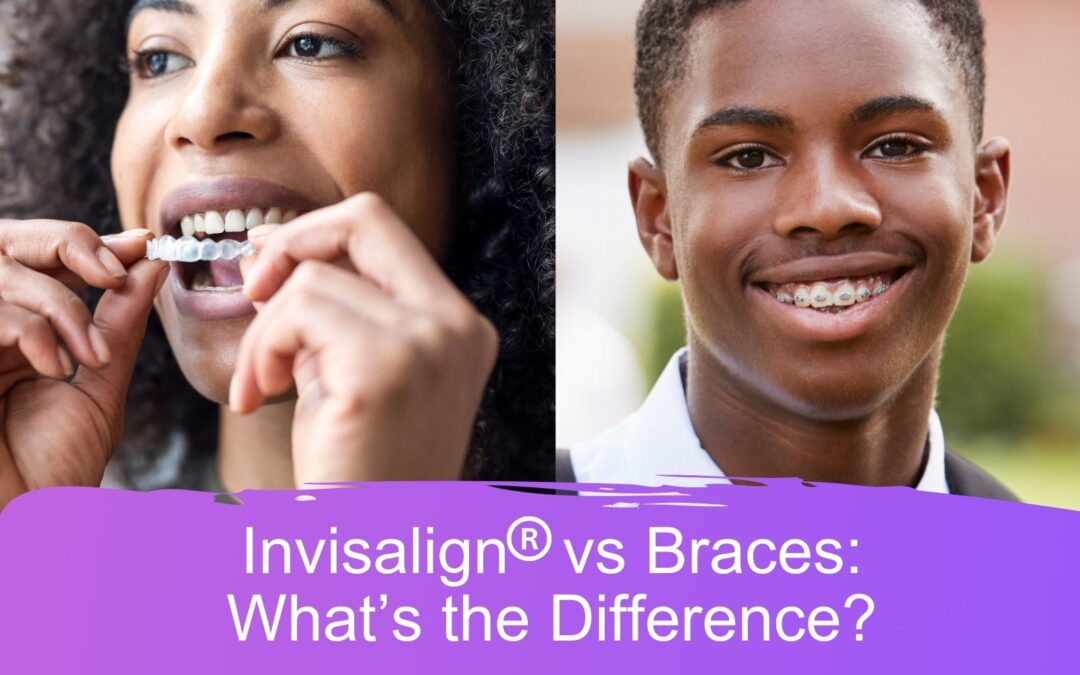Invisalign vs. Braces: Discover the Different Orthodontic Treatments And Learn Which Is Right for You?
Embarking on the journey towards a confident, beautiful smile by straightening your teeth is exciting. Straight and healthy teeth can transform your face and life.
However, with multiple orthodontic treatment options available, including traditional braces and Invisalign clear aligners, it’s important to understand their differences to determine the right choice for you.
This guide will compare braces and Invisalign to help you decide your orthodontic treatment.
Invisalign vs. Braces – Effectiveness:
Braces: Traditional braces shift teeth into alignment using brackets, wires, and bands. As we know them today, the modern form of metal braces began to gain popularity in the mid-20th century. Metal braces are very effective for treating complex orthodontic issues, such as severe overcrowding, misalignment, and bite problems.
Metal braces have remained a cornerstone of orthodontic treatment, providing effective and predictable results for patients of all ages. While alternative orthodontic options, such as ceramic braces and clear aligners like Invisalign, have become available in recent years, metal braces are widely used for their affordability, durability, and versatility in treating many orthodontic issues.
Invisalign: Invisalign is a dental treatment involving a set of clear and detachable aligners specifically created to fit securely over your teeth. Invisalign is most suitable for mild to moderate orthodontic issues like minor crowding or spacing. It may not be effective for more severe cases.
Since it became available in 1999, Invisalign has become one of the most popular and widely recognized clear aligner systems worldwide, offering patients a discreet, convenient, and effective way to straighten their teeth without the visibility and restrictions associated with traditional braces. Over the years, Align Technology has continued to innovate and refine the Invisalign system, introducing new features, materials, and treatment options to meet the evolving needs of patients and orthodontic professionals.
Invisalign vs. Braces – Appearance:
Braces: Metal braces are visible on the teeth and very noticeable when you smile. However, advancements in orthodontic technology have led to smaller, sleeker braces that are less conspicuous than ever before.
Invisalign: Invisalign aligners are preferred when you want a discreet and nearly invisible solution. The aligners are made of clear materials that blend perfectly with your natural teeth, making them almost unnoticeable when you wear them. This way, you can smile with confidence throughout the treatment without any worry or embarrassment.
Invisalign vs. Braces – Comfort:
Braces: Metal braces, which use metal brackets and wires, may cause discomfort or irritation by rubbing against the cheeks, lips, and tongue. However, orthodontic wax and other remedies can help alleviate pain during adjustment.
Invisalign: Invisalign aligners are made of smooth, comfortable plastic material that minimizes irritation to the mouth’s soft tissues. Most patients find Invisalign to be more comfortable to wear than traditional braces.
Invisalign vs. Braces – Maintenance:
Braces: With braces, maintaining good oral hygiene is essential to prevent plaque buildup and minimize the risk of tooth decay and gum disease. Most patients need specialized tools like floss threaders and interdental brushes to clean around the brackets and wires.
Invisalign: Invisalign aligners are designed to be easily removable so you can maintain your usual oral hygiene routine. Remove the aligners first when you need to eat or drink anything other than water. After that, you can clean them using a soft toothbrush and lukewarm water to ensure they stay fresh and hygienic.
Invisalign vs. Braces – Treatment Duration:
Braces: The complexity of your orthodontic issues will dictate the duration of treatment. On average, treatment with braces typically lasts between 18 to 36 months.
Invisalign: Treatment with Invisalign may be shorter than braces, with most patients achieving their desired results within 12 to 18 months. However, the duration of treatment may vary based on individual factors, compliance, and treatment goals.
Both braces and Invisalign offer effective solutions for straightening teeth and achieving a beautiful, healthy smile. Ultimately, the right orthodontic treatment depends on your individual needs, preferences, and lifestyle. Consult with our board-certified orthodontist and our Silver Level Invisalign providers to discuss your options and determine which treatment best aligns with your goals and expectations. Whether you choose traditional braces or Invisalign, you’re one step closer to a confident, radiant smile that lasts a lifetime.
can significantly affect the overall success and satisfaction of orthodontic treatment.
Schedule a consultation with our very own board-certified orthodontist, Dr. Hao. You can do this by calling 773-481-2200, or schedule online here.
- What is orthodontics?
- What is an orthodontist?
- Why should I chose and orthodontist over a regular dentist?
- What is a Board-Certified Orthodontist?
- What are retainers?
- What is Invisalign®?
- When is Invisalign® appropriate versus metal braces?
- Why straighten my teeth?
- The Ultimate Guide to Getting Braces in Chicago: What You Need to Know

